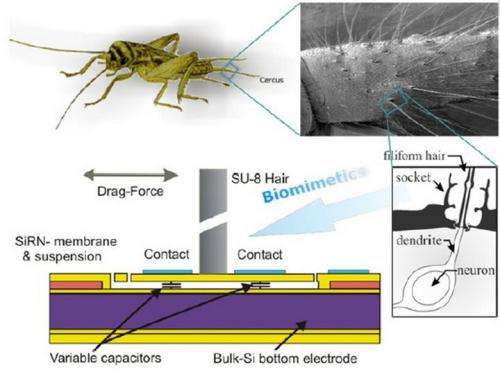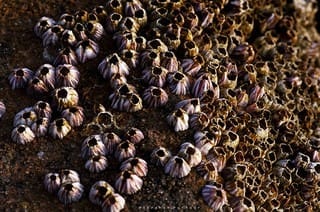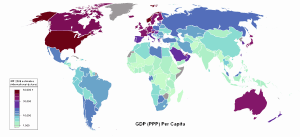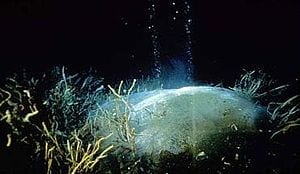
One of the top ten highlights of the past year, in terms of technology that is inspired by nature.
That was how the journal “Bioinspiration & Biomimetics” described a paper by researchers from the University of Twente’s MESA+ Institute for Nanotechnology. The publication describes new technology involving the use of sensors to measure flow patterns. Source of inspiration: the hairs on cricket abdomens.
Crickets use sensitive hairs on their cerci (projections on the abdomen) to detect predators. For these insects, air currents carry information about the location of nearby predators and the direction in which they are moving. These University of Twente researchers wondered whether they could use the same principle to create a new kind of “camera”, capable of imaging entire flow patterns rather than measuring flows at a single point. They mimic the cricket hairs using microtechnology. The hairs themselves are made of a type of epoxy, which is attached to a flexible suspended plate. That acts as a capacitor, whose capacitance varies with movement. Measuring that variation gives you information about the movement. Using an entire field or array of such fine hairs, it is possible to identify patterns in the flow, in much the same way as complete images are formed from the individual pixels detected by chips in cameras.
Flow camera
The trick is then to be able to read each hair individually. To this end, a range of options have been explored. Frequency Division Multiplexing (FDM) offers the greatest advantages. With FDM, the measured signal is not delayed while in transit, it is not difficult to synchronize the individual sensors, and the sensor array can easily be expanded without sacrificing performance. Also, the hardware involved is less complex than that required by other technologies. Looking ahead, the researchers believe that it will ultimately be a relatively simple matter to integrate the sensors and the hardware. This will result in a “camera” that is capable of imaging flow patterns. These could be used as a motion detection system in robots, for example.
The Latest Bing News on:
Bio-inspired Technology
- How a Controversial Cryonics Procedure Could Finally Make Immortality Possibleon May 1, 2024 at 10:53 am
Futurists, including some medical doctors, are signing up to be decapitated—and then have their brains frozen. But without a body, what will their minds become?
- Matchbox Debuts Mercedes-Benz G 580 with EQ Technology Die-Cast Caron May 1, 2024 at 8:56 am
Matchbox has additional plans for more Mercedez-Benz electric vehicles coming later this year to its Moving Parts Series. The new Matchbox Mercedes-Benz G 580 With EQ Technology is available for ...
- Engineered living materials: Scientists 3D print with bio-ink made from tobacco cellson May 1, 2024 at 5:03 am
Also known as EPLMs, “engineered plant living materials” are a new frontier that marries synthetic biology and 3D printing, an invention that’s inspired many improvements to the mechanism itself as ...
- Polestar just showed off charging tech even Tesla can't rivalon April 29, 2024 at 5:59 am
But Polestar just showed off a charging technology that even Tesla can't rival. A Polestar 5 with StoreDot's XFC cells on board – described by the company as a "reinvention of the battery chemistry, ...
- 3D Printed Silk Bio-Ink Shows Potential for Knee Meniscus Repairon April 24, 2024 at 7:00 am
Researchers have developed a silk-based bio-ink to 3D print a meniscus for better knee repair and regeneration.
- World leading expert on bio-inspired AI to direct University of Sheffield’s Centre for Machine Intelligenceon April 22, 2024 at 3:03 am
One of the world’s leading innovators in bio-inspired AI has joined the University of Sheffield, as part of a new multi-million pound centre that is set to transform the institution’s research, ...
- Essex Bio-Technology Ltdon April 18, 2024 at 5:00 pm
We sell different types of products and services to both investment professionals and individual investors. These products and services are usually sold through license agreements or subscriptions ...
- Video: Bio-inspired aquatic robot shoots through the water like a penguinon April 18, 2024 at 11:21 am
Penguins are fast, fantastic swimmers, so why not make an underwater robot inspired by them? That's just what German underwater tech company EvoLogics has done, with its new-and-improved Quadroin AUV ...
- Q Bio Unveils New MRI Technology - Tensor Field Mapping - Advancing Measurement in Medical Imagingon April 9, 2024 at 3:00 am
April 09, 2024--(BUSINESS WIRE)--Q Bio Inc., an innovator in medical imaging technology, today announced the launch of Tensor Field Mapping (TFM), a new technology for Magnetic Resonance Imaging ...
- Windfall Bio secures $28m in Series A funding to advance methane capture technologyon April 8, 2024 at 5:00 pm
Windfall Bio, a provider of methane-to-value solutions, has closed a $28 million Series A funding round led by Prelude Ventures. Notable participation came from Amazon’s Climate Pledge Fund ...
The Latest Google Headlines on:
Bio-inspired Technology
[google_news title=”” keyword=”Bio-inspired Technology” num_posts=”10″ blurb_length=”0″ show_thumb=”left”] [/vc_column_text]The Latest Bing News on:
Biomimetics
- 5 Stunning Photos That Demonstrate Why Fish Are Often Found In Groupson April 21, 2024 at 5:15 am
Contrary to popular belief, schools and shoals aren’t interchangeable terms. While schools refer to groups of fish that swim in a highly synchronized and organized manner, often in the same direction ...
- Study finds schools of fish can make less noise than a solitary swimmeron April 9, 2024 at 7:12 am
The work is published in Bioinspiration & Biomimetics. The team created a 3D model based on the common mackerel to simulate different numbers of fish swimming, changing up their formations ...
- What’s quieter than a fish? A school of themon April 9, 2024 at 3:01 am
The work is newly published in Bioinspiration & Biomimetics. The team created a 3D model based on the common mackerel to simulate different numbers of fish swimming, changing up their formations ...
- What's quieter than a fish? A school of themon April 8, 2024 at 5:00 pm
The work is newly published in Bioinspiration & Biomimetics. The team created a 3D model based on the common mackerel to simulate different numbers of fish swimming, changing up their formations ...
- Biomimetics articles from across Nature Portfolioon April 3, 2024 at 5:00 pm
Biomimetics is an interdisciplinary field in which principles from engineering, chemistry and biology are applied to the synthesis of materials, synthetic systems or machines that have functions ...
- Medical Biomimetics Market Size is projected to reach USD 54.25 billion by 2031, growing at a CAGR of 6.5%: Straits Researchon March 13, 2024 at 5:01 pm
New York, United States, March 14, 2024 (GLOBE NEWSWIRE) -- Medical biomimetics, also known as biomimicry or bioinspired technology, is a field that creates and develops novel medical treatments ...
- A new strategy to regulate the stiffness of snake-inspired robotson December 27, 2023 at 5:32 am
Their proposed method, outlined in the journal Bioinspiration & Biomimetics, was applied to the development of a snake-like robotic arm with 20 degrees of freedom (DoF). "Snake robots have been widely ...
- GCSE Design and Technology: Biomimetics - Designed by Natureon October 17, 2023 at 5:22 am
Fran Scott takes a unique look into some of the latest biomimetics technology and talks to some of the pioneers working on ways to interpret nature's biological mechanisms. This series features ...
- Ferguson Biomechanics and Biomimetics Labon January 14, 2019 at 2:19 am
Our group has a long-standing focus on developing new methods and protocols to for microscopy (i.e., visualizing) and nano- and micro-mechanical testing of hydrated, heterogeneous, porous, and ...
- Analyst View: Biomimetics for the Internet of Thingson August 25, 2016 at 5:00 pm
Value stream management involves people in the organization to examine workflows and other processes to ensure they are deriving the maximum value from their efforts while eliminating waste — of ...
The Latest Google Headlines on:
Biomimetics
[google_news title=”” keyword=”Biomimetics” num_posts=”10″ blurb_length=”0″ show_thumb=”left”]










